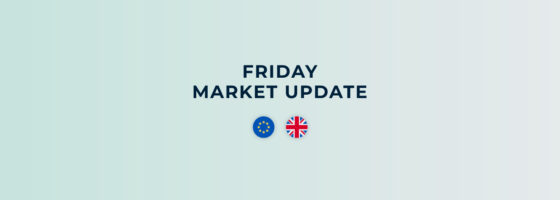Real yields are starting to bite
Last week was all about global investors pushing up bond yields at the long end in an attempt to price in the possibility of a higher for longer scenario in the developed world. This stands in stark contrast to the first six months of the year, during which rates on 2-year government bond yields had risen vastly more than their 10-year counterpart. However, with central banks not backing down from their commitment to fight inflation and economic growth, while slowing, still being above trend, investors had no choice but to sell fixed income products.
Higher financing costs have been limiting the advance of global equity markets, with most stock benchmarks throughout Europe and the US being down on the week and month. With the Nasdaq, S&P500 and Stoxx 600 being down around 6-9% since finding multi-month highs in July, the US dollar has risen for five consecutive weeks. The advance has been slow and measured, showing no signs of panic buying. However, investors have turned cautious in recent weeks with China underperforming and the US 30-year real yield back above 2% for the first time since 2011.
Going into the week, the upcoming purchasing manager indices (PMIs) for most developed countries will be in focus on the macro side. However, the real highlight will come in the form of the Jackson Hole Symposium on Thursday and Friday, where Fed Chair Jerome Powell and other central bankers will give us a glance into their thinking.

China is Europe’s problem, really
China has been all over the news recently with investors asking themselves how bad the property crisis in the world’s second largest economy really is? With Country Garden, the once largest property developer in China, trying to stave off a downward spiral and firms covering 40% of Chinese home sales having already defaulted, markets have been on edge as of late.
Beijing’s attempt to deleverage the highly indebted property sector starting from 2020 with the introduction of new preventive measures under the three red lines policy has come with a price. Not only have stocks of home builders suffered, but hard data is also showing that the real estate market is adding less to Chinese growth than what investors got accustomed to. New home sales in China have decreased by a third in the 12 months till July 2023. This has led to new home prices in the 35 smallest cities surveyed by the National Bureau of Statistics falling 17 months in a row. Today’s cut of the short-term benchmark interest rate (1-year LPR) by only 10 basis points has also disappointed investors, who were hoping for more easing, pushing Chinese stocks to a 9-month low.
The euro has been more influenced by the Fed and China than by regional macroeconomic developments, which is why EUR/USD has been falling for five weeks now. At a level of around $1.0850, the currency pair is approaching the medium-term supporting trend at $1.08. The European PMIs and the German Ifo will be in focus this week, with the consensus expecting both indicators to stagnate at suppressed levels.

6% peak back on the table
The pound remains supported from rising UK yields as Bank of England (BoE) rate expectations climb following the influx of UK macro data last week. Markets are currently pricing a 57% chance that the BoE will lift its key interest rate to 6% by December this year. This week, flash PMIs and business surveys from the Confederation of British Industry (CBI) are in the spotlight.
The CBI surveys measure the health of the retail sector and provide insight and trends on domestic and export orders, stocks, price, investment intentions and output expectations. They are important leading indicators for the UK economy. For example, CBI price expectations track BoE inflation forecasts almost perfectly. Meanwhile, we expect the UK PMIs to highlight ongoing problems in manufacturing and mounting stagnation in the service sector, which the BoE is most focussed on given the stickiness of services inflation. Although we’ve seen headline UK inflation dip below 7% and real wages in positive territory as a result, both core and services inflation are proving more stubborn. Hence, markets are betting on the BoE hiking interest rates more than its peers through the rest of 2023, which is buoying demand for the high-yielding pound.
GBP/EUR has climbed above €1.17 thanks to the widening UK-German yield differential and could continue its ascent towards €1.18 in the short-term. GBP/USD snapped a 4-week losing streak last week, finding support just above $1.26, although failed to print a new weekly high – keeping the downtrend intact for now.

Sterling pound fends of global risk aversion
Table: 7-day currency trends and trading ranges

Key global risk events
Calendar: August 21-25

Have a question? [email protected]
*The FX rates published are provided by Convera’s Market Insights team for research purposes only. The rates have a unique source and may not align to any live exchange rates quoted on other sites. They are not an indication of actual buy/sell rates, or a financial offer.



